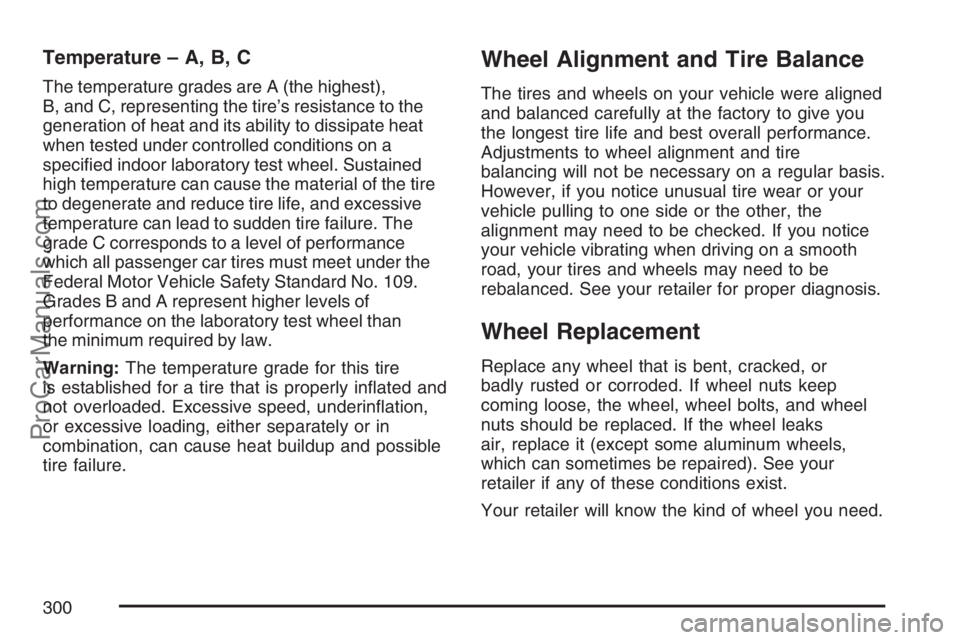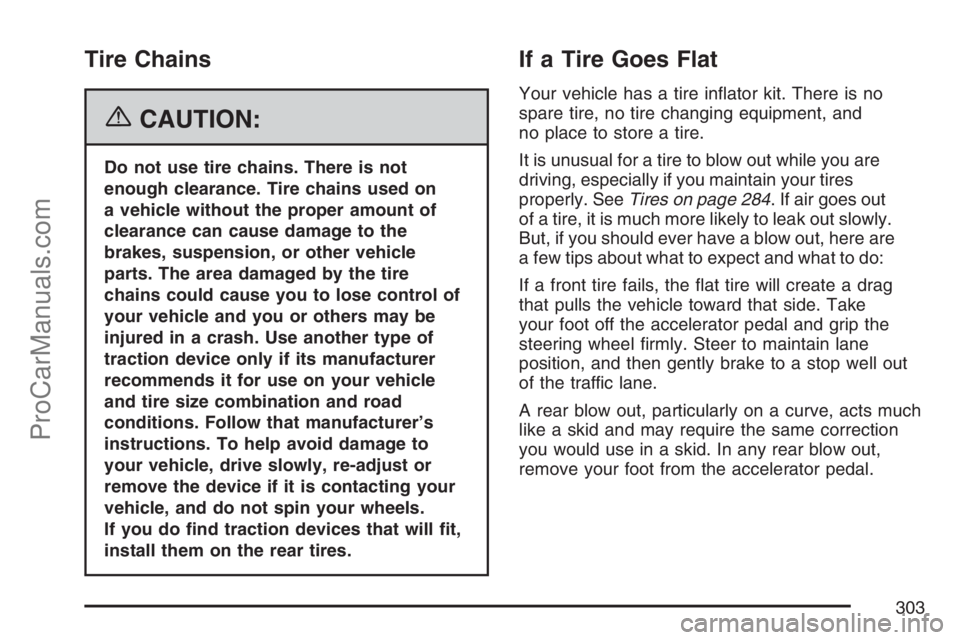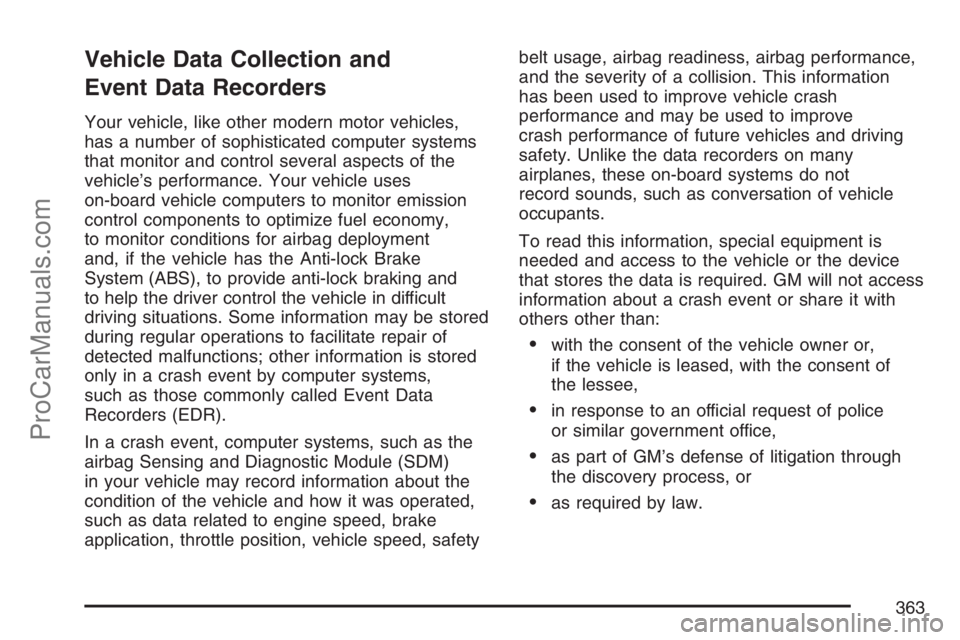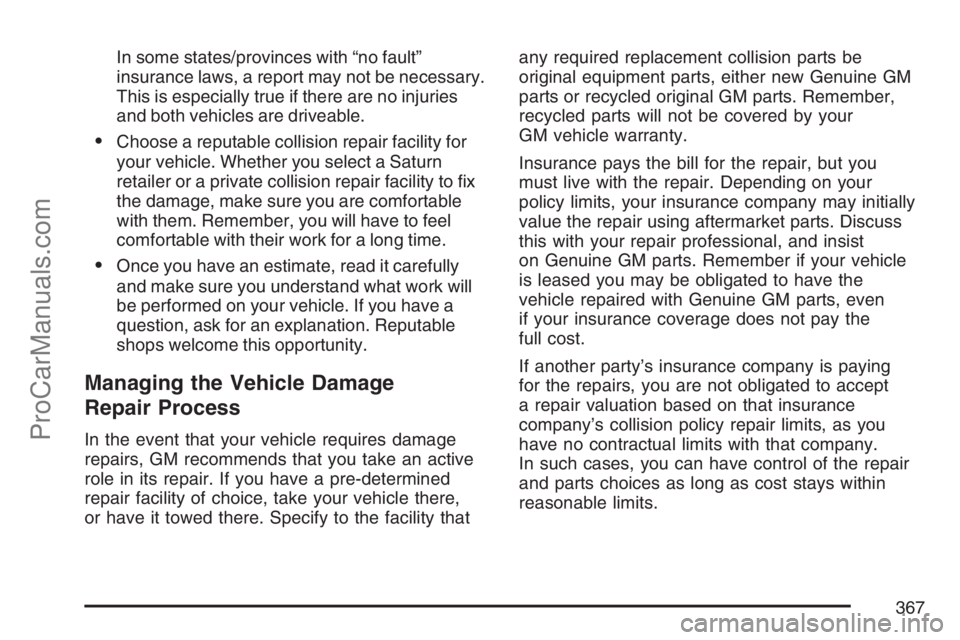ESP SATURN SKY 2007 Owner's Manual
[x] Cancel search | Manufacturer: SATURN, Model Year: 2007, Model line: SKY, Model: SATURN SKY 2007Pages: 384, PDF Size: 2.47 MB
Page 300 of 384

Temperature – A, B, C
The temperature grades are A (the highest),
B, and C, representing the tire’s resistance to the
generation of heat and its ability to dissipate heat
when tested under controlled conditions on a
speci�ed indoor laboratory test wheel. Sustained
high temperature can cause the material of the tire
to degenerate and reduce tire life, and excessive
temperature can lead to sudden tire failure. The
grade C corresponds to a level of performance
which all passenger car tires must meet under the
Federal Motor Vehicle Safety Standard No. 109.
Grades B and A represent higher levels of
performance on the laboratory test wheel than
the minimum required by law.
Warning:The temperature grade for this tire
is established for a tire that is properly in�ated and
not overloaded. Excessive speed, underin�ation,
or excessive loading, either separately or in
combination, can cause heat buildup and possible
tire failure.
Wheel Alignment and Tire Balance
The tires and wheels on your vehicle were aligned
and balanced carefully at the factory to give you
the longest tire life and best overall performance.
Adjustments to wheel alignment and tire
balancing will not be necessary on a regular basis.
However, if you notice unusual tire wear or your
vehicle pulling to one side or the other, the
alignment may need to be checked. If you notice
your vehicle vibrating when driving on a smooth
road, your tires and wheels may need to be
rebalanced. See your retailer for proper diagnosis.
Wheel Replacement
Replace any wheel that is bent, cracked, or
badly rusted or corroded. If wheel nuts keep
coming loose, the wheel, wheel bolts, and wheel
nuts should be replaced. If the wheel leaks
air, replace it (except some aluminum wheels,
which can sometimes be repaired). See your
retailer if any of these conditions exist.
Your retailer will know the kind of wheel you need.
300
ProCarManuals.com
Page 303 of 384

Tire Chains
{CAUTION:
Do not use tire chains. There is not
enough clearance. Tire chains used on
a vehicle without the proper amount of
clearance can cause damage to the
brakes, suspension, or other vehicle
parts. The area damaged by the tire
chains could cause you to lose control of
your vehicle and you or others may be
injured in a crash. Use another type of
traction device only if its manufacturer
recommends it for use on your vehicle
and tire size combination and road
conditions. Follow that manufacturer’s
instructions. To help avoid damage to
your vehicle, drive slowly, re-adjust or
remove the device if it is contacting your
vehicle, and do not spin your wheels.
If you do �nd traction devices that will �t,
install them on the rear tires.
If a Tire Goes Flat
Your vehicle has a tire in�ator kit. There is no
spare tire, no tire changing equipment, and
no place to store a tire.
It is unusual for a tire to blow out while you are
driving, especially if you maintain your tires
properly. SeeTires on page 284. If air goes out
of a tire, it is much more likely to leak out slowly.
But, if you should ever have a blow out, here are
a few tips about what to expect and what to do:
If a front tire fails, the �at tire will create a drag
that pulls the vehicle toward that side. Take
your foot off the accelerator pedal and grip the
steering wheel �rmly. Steer to maintain lane
position, and then gently brake to a stop well out
of the traffic lane.
A rear blow out, particularly on a curve, acts much
like a skid and may require the same correction
you would use in a skid. In any rear blow out,
remove your foot from the accelerator pedal.
303
ProCarManuals.com
Page 360 of 384

The following services are provided in the U.S.
during the Bumper-to-Bumper warranty period and
in Canada, during the Base Warranty coverage
period of the New Vehicle Limited Warranty, up to
a maximum coverage of $100.
Fuel Delivery:Delivery of enough fuel for the
customer to get to the nearest service station
(approximately $5 in the U.S. and 10 litres
in Canada). Service to provide diesel may
be restricted. For safety reasons, propane
and other alternative fuels will not be provided
through this service.
Lock-out Service:To ensure security, the
driver must present the vehicle registration
and personal ID before lock-out service
is provided. Lock-out service will be covered
at no charge if you are unable to gain
entry into your vehicle. If you vehicle will not
start, Roadside Assistance will arrange to have
your vehicle towed to the nearest authorized
retailer. In the U.S., replacement keys made
at the customer’s expense will be delivered
within 10 miles.
Emergency Tow From a Public Roadway
or Highway:Tow to the nearest Saturn
retailer for warranty service or in the event
of a vehicle-disabling accident. Winch-out
assistance provided when the vehicle is mired
in sand, mud, or snow.
Flat Tire Change:If your vehicle has a spare
time, installation of that tire, in good condition,
will be covered at no charge. The customer
is responsible for the repair or replacement
of the tire if not covered by a warrantable
failure.
Jump Start:No-start occurrences which
require a battery jump start will be covered
at no charge.
360
ProCarManuals.com
Page 361 of 384

Additional Services for Canadian
Customers
Trip Routing Service:Upon request,
Roadside Assistance will send you detailed,
computer personalized maps, highlighting your
choice of either the most direct route or the
most scenic route to your destination,
anywhere in North America, along with any
helpful travel information we may have
pertaining to your trip. To request this service,
please call us toll-free at 1-800-268-6800.
We will make every attempt to send your
personalized trip routing as quickly as possible,
but it is best to allow three weeks before your
planned departure date. Trip routing requests
will be limited to six per calendar year.
Trip Interruption Bene�ts and Assistance:
In the event of a warranty related vehicle
disablement, while en route and over
250 kilometres from original point of departure,
you may qualify for trip interruption expense
assistance. This assistance covers reasonable
reimbursement of up to a maximum of
$500 (Canadian) for (A) meals (maximum of
$50/day), (B) lodging (maximum of $100/night),and (C) alternate ground transportation
(maximum of $40/day). This bene�t is to assist
you with some of the unplanned expense you
may incur while waiting for your vehicle to be
repaired.
Pre-authorization, original detailed receipts and
a copy of the repair order are required.
Once authorization has been given, your
advisor will help you make any necessary
arrangements and explain how to claim for trip
interruption expense assistance.
Alternative Service:There may be times when
Roadside Assistance cannot provide timely
assistance, your advisor may authorize you to
secure local emergency road service, and you
will be reimbursed up to $100 upon submission
of the original receipt to Roadside Assistance.
In many instances, mechanical failures are
covered under Saturn’s Bumper-to-Bumper
warranty for U.S. customers, and the duration
of the Base Warranty Coverage for Canadian
customers of the New Vehicle Limited Warranty.
However, any cost for parts and labor for
non-warranty repairs are the responsibility of
the driver.
361
ProCarManuals.com
Page 363 of 384

Vehicle Data Collection and
Event Data Recorders
Your vehicle, like other modern motor vehicles,
has a number of sophisticated computer systems
that monitor and control several aspects of the
vehicle’s performance. Your vehicle uses
on-board vehicle computers to monitor emission
control components to optimize fuel economy,
to monitor conditions for airbag deployment
and, if the vehicle has the Anti-lock Brake
System (ABS), to provide anti-lock braking and
to help the driver control the vehicle in difficult
driving situations. Some information may be stored
during regular operations to facilitate repair of
detected malfunctions; other information is stored
only in a crash event by computer systems,
such as those commonly called Event Data
Recorders (EDR).
In a crash event, computer systems, such as the
airbag Sensing and Diagnostic Module (SDM)
in your vehicle may record information about the
condition of the vehicle and how it was operated,
such as data related to engine speed, brake
application, throttle position, vehicle speed, safetybelt usage, airbag readiness, airbag performance,
and the severity of a collision. This information
has been used to improve vehicle crash
performance and may be used to improve
crash performance of future vehicles and driving
safety. Unlike the data recorders on many
airplanes, these on-board systems do not
record sounds, such as conversation of vehicle
occupants.
To read this information, special equipment is
needed and access to the vehicle or the device
that stores the data is required. GM will not access
information about a crash event or share it with
others other than:
with the consent of the vehicle owner or,
if the vehicle is leased, with the consent of
the lessee,
in response to an official request of police
or similar government office,
as part of GM’s defense of litigation through
the discovery process, or
as required by law.
363
ProCarManuals.com
Page 367 of 384

In some states/provinces with “no fault”
insurance laws, a report may not be necessary.
This is especially true if there are no injuries
and both vehicles are driveable.
Choose a reputable collision repair facility for
your vehicle. Whether you select a Saturn
retailer or a private collision repair facility to �x
the damage, make sure you are comfortable
with them. Remember, you will have to feel
comfortable with their work for a long time.
Once you have an estimate, read it carefully
and make sure you understand what work will
be performed on your vehicle. If you have a
question, ask for an explanation. Reputable
shops welcome this opportunity.
Managing the Vehicle Damage
Repair Process
In the event that your vehicle requires damage
repairs, GM recommends that you take an active
role in its repair. If you have a pre-determined
repair facility of choice, take your vehicle there,
or have it towed there. Specify to the facility thatany required replacement collision parts be
original equipment parts, either new Genuine GM
parts or recycled original GM parts. Remember,
recycled parts will not be covered by your
GM vehicle warranty.
Insurance pays the bill for the repair, but you
must live with the repair. Depending on your
policy limits, your insurance company may initially
value the repair using aftermarket parts. Discuss
this with your repair professional, and insist
on Genuine GM parts. Remember if your vehicle
is leased you may be obligated to have the
vehicle repaired with Genuine GM parts, even
if your insurance coverage does not pay the
full cost.
If another party’s insurance company is paying
for the repairs, you are not obligated to accept
a repair valuation based on that insurance
company’s collision policy repair limits, as you
have no contractual limits with that company.
In such cases, you can have control of the repair
and parts choices as long as cost stays within
reasonable limits.
367
ProCarManuals.com